Family : Callionymidae

Text © Giuseppe Mazza

English translation by Mario Beltramini
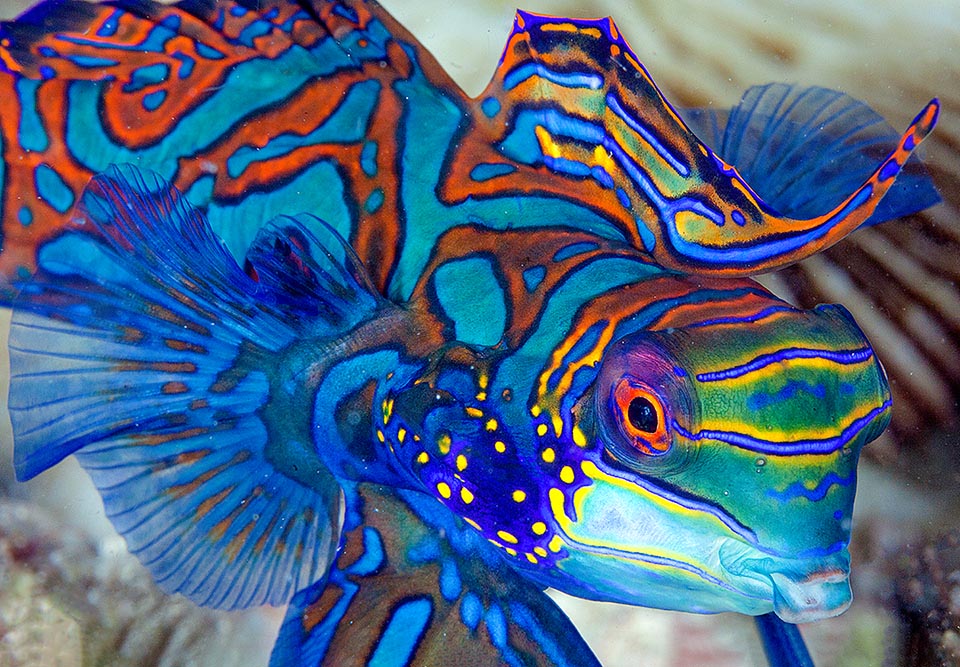
Only 6-7 cm long, the Mandarinfish (Synchiropus splendidus) is one of the most picturesque inhabitants of the Western Pacific reefs © Klaus Stiefel
The Mandarinfish (Synchiropus splendidus Herre, 1927) belongs to the class of the Actinopterygii, the ray-finned fishes, to the order Perciformes and to the Callionymidae, a family of benthic fishes evolutionarily close to the Gobiidae, that counts about twenty genera and almost 200 species commonly called dragonets because of their odd look, without scales.
Under the skin, on the preoperculum, they have a well developed spine that causes painful wounds, taking a long time to heal, hence in various languages the recurring name of weaver fish.
The name of the genus Synchiropus comes from the Greek “συν” (syn), with, “χείρ”(cheir), hand, and “πούς” (pus), foot, with reference to the fins used like feet.
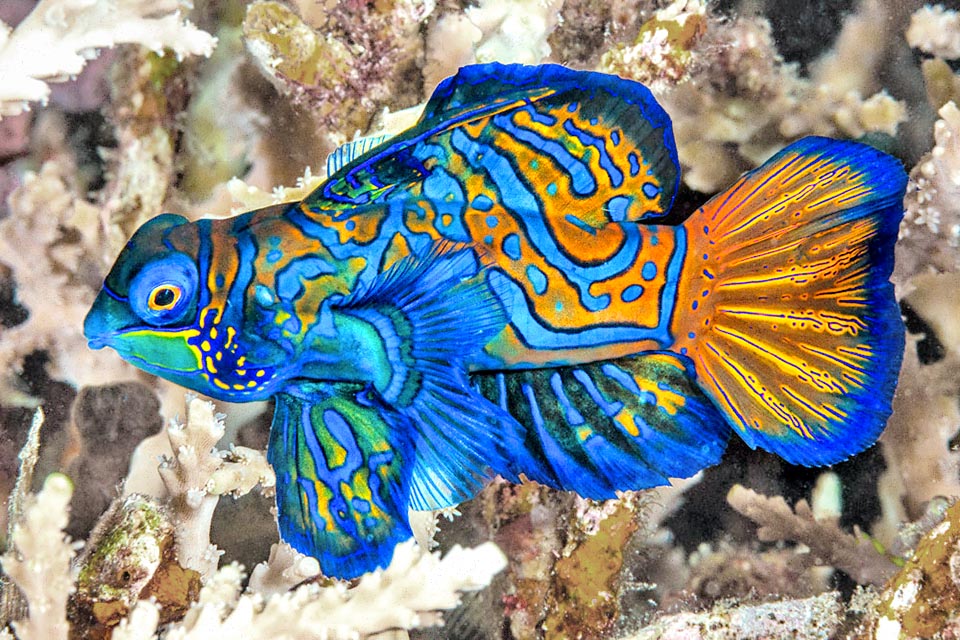
A male in all its splendor. The long spiny ray of the first dorsal fin, here folded, distinguishes it at first sight from the females © François Libert
The specific name, rightly, simply means splendid in Latin.
Zoogeography
The Mandarinfish is at home in the tropical waters of the Western Pacific. Indicatively, we find it, north-eastwards, in Malaysia, Indonesia, Philippines, Taiwan and Ryukyu Islands up to the southern part of Japan and, south-eastwards, in the Palau Islands, in Micronesia, Papua New Guinea, Solomon Islands, Australia and New Caledonia.
Ecology-Habitat
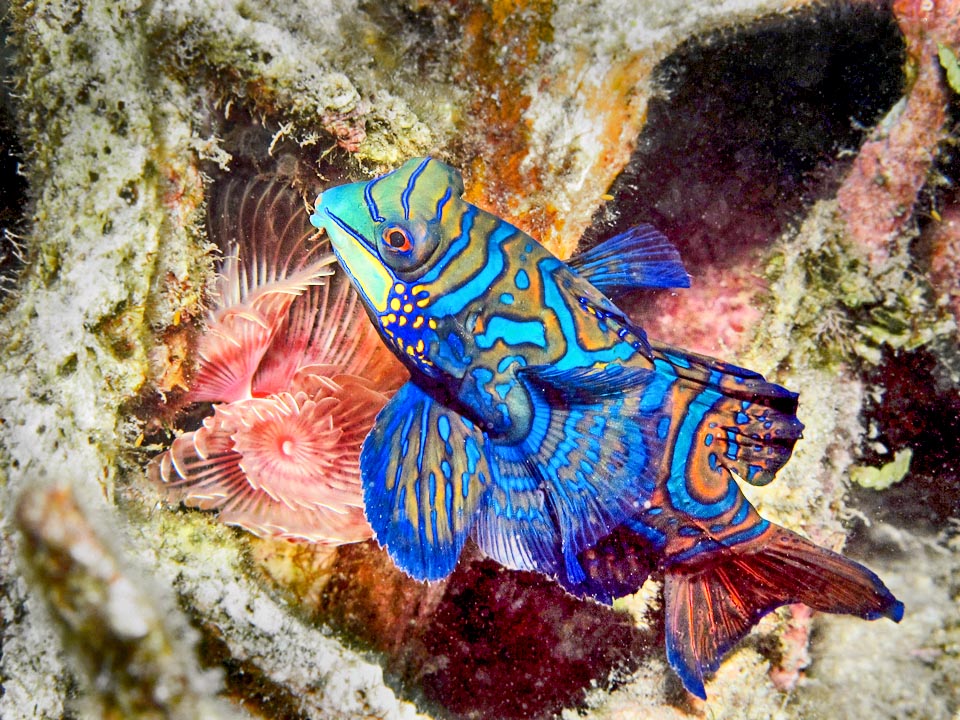
It has no scales but is protected by a venomous mucus and patrols the seabeds all day feeding on small crustaceans and eggs © Pauline Walsh Jacobson
It lives in shallow waters in the madreporic formations of the lagoons. It has been sighted even at 12 m of depth, but usually it follows the contour of the seabed in the first 6 m of water, protected by the ramifications of the corals and of the very long spines of the Diadema sea urchins (Diadema setosum).
Morphophysiology
The 6-7 cm long body is cylindriform, with two big protruding eyes placed high on the triangular and pointed head.
The mouth is protractile with several rows of tiny teeth.
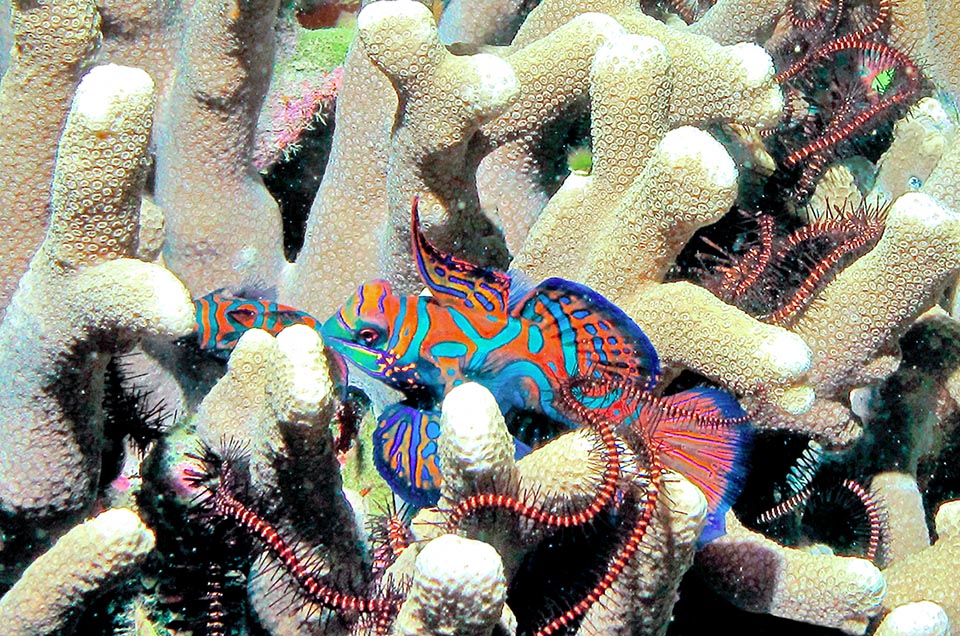
Lives sheltered among the corals ramifications or the long urchins spines but in the evening often goes out from the hideouts to reproduce © Bernard Dupont
There are two separate dorsal fins the fish unfolds when needed, like sails, in order to appear bigger. The first has 4 spiny rays and the second 8-9 soft. In the males, bigger and lore coloured than the females, the first spiny ray is particularly developed, at least twice as long as the others, and this the most evident sexual dimorphism.
The first anal counts 6-8 unarmed rays; the big pectoral ones 28-35 soft rays and the pelvic, relatively big, up to 5 unarmed rays.
They are used for advancing almost slipping on the seabeds whilst the pectoral fins move waving madly, and even if without swim bladder, with strong tail blows, Synchiropus splendidus is also capable of rising to the surface for reproducing or for darting away fast in case of danger.
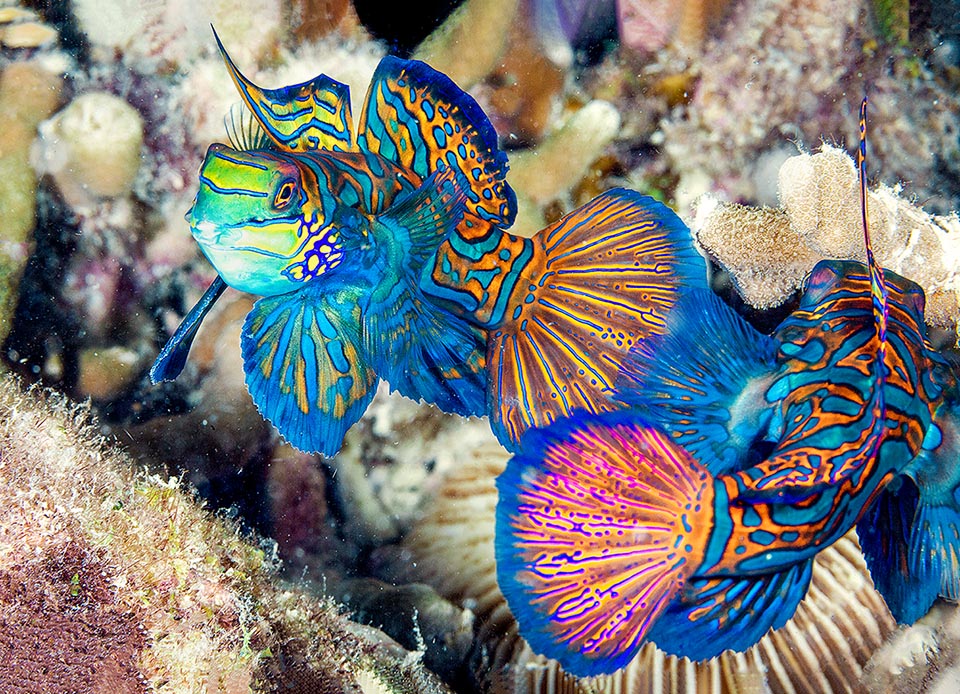
Males are more numerous than the females ready to spawn and often occur fights with spectacular displays of strength between competitors © Klaus Stiefel
The gill slits are reduced to small orifices. Having no scales, the body is protected by a toxic mucus that defends it from the parasites. When the fish is threatened or is under stress, the same is secreted abundantly and deters the predators with a strong unpleasant odour.
The livery stands among the most beautiful in the world of fishes, so much to lead to think, as the vulgar name states, to a luxurious dress of a Chinese mandarin.
On the reddish brown up to brick red background, se note dottings and elegant mimetic drawings of light blue or turquoise colour, edged in black, that continue on the fins ending in a vertical band at the beginning of the caudal peduncle. The nature of this blue colour is not due to the incidence of light, as often occurs, but to a dye. The iris is orange red, the chin strap is clear, and before the pectorals we note a dark zone adorned with orange yellow spots.
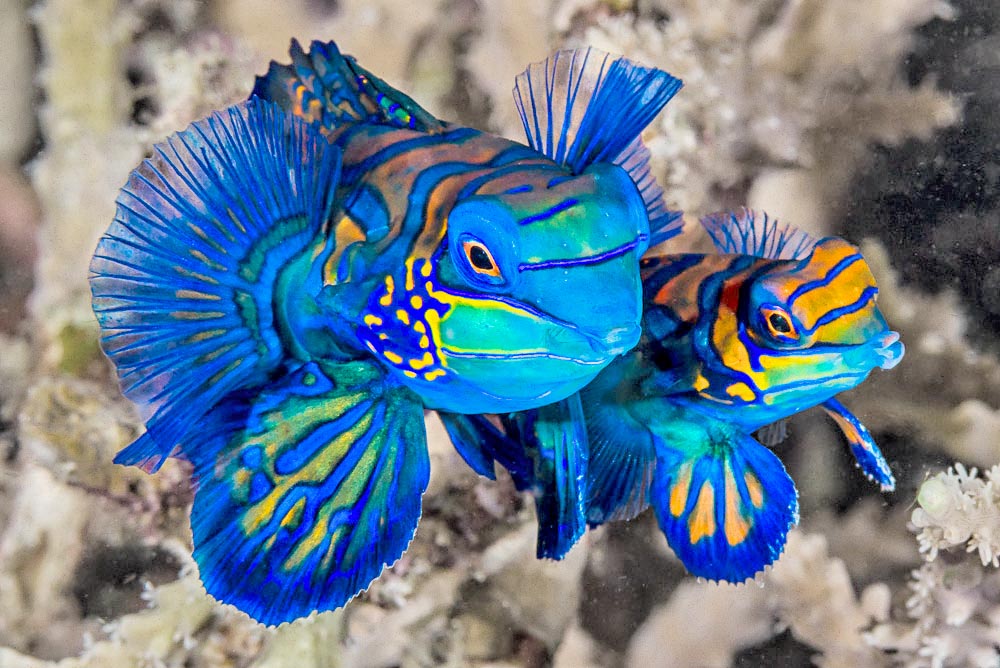
Here a winner who has seduced a partner. The females are smaller but can produce even 200 eggs © François Libert
In nature two forms of colour exist, with the red in lieu of the orange, and the green may appear with different shades, not to forget rare wholly red black striped specimens, and since when bred for trade other variants are then present in the shops.
Ethology-Reproductive Biology
Synchiropus splendidus lives alone feeding mainly on small crustaceans and eggs it pecks like a small bird among the corals with its protruding lips.
Almost every evening, at dusk, when the diurnal fishes go to sleep and the nocturnal ones are not yet around, the Mandarinfishes exit from their hideouts for reproducing at about one metre over the reef.
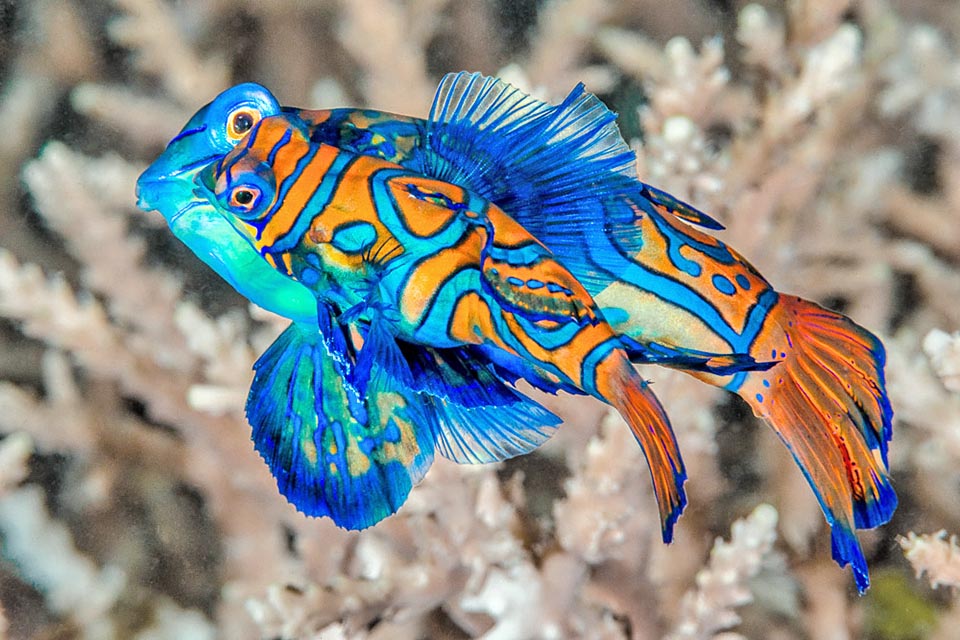
Coupling is not easy as it happens on the surface and they are fishes without swim bladder who if they stop they sink. They must do it, cheek to cheek, in fits and starts © François Libert
Matings, as the females are less numerous because they need at least one week for recovering between one deposition and the following, are almost always preceded by disputes among males.
After chasing aways the rivals and seduced a female, swimming around it and waving hard the fins spread out for showing its prowess, the winning male goes back up to the surface wriggling belly to belly with the partner.
As they don’t have the swim bladder, the two, after some ten metres, inevitably lose height, but they don’t discourage and forcing the muscles, always more excited, continue to go up in fits and starts cheek to cheek, increasingly synchronized in the movements, until when, close to the surface, they can unite their anal fins to form a sort of a cylindrical container intended to collect the sperm and the eggs.
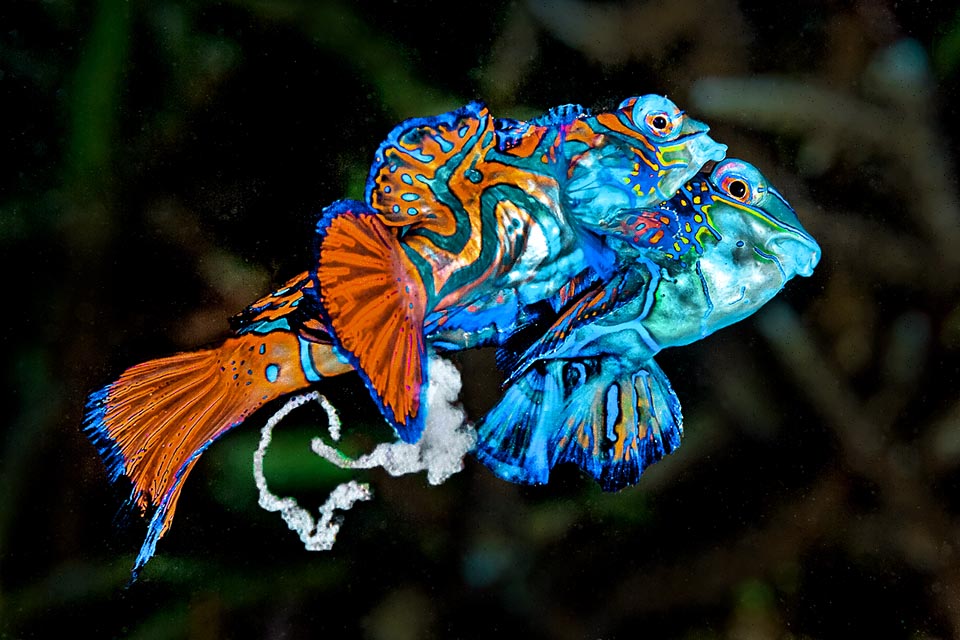
Here they are flying, embraced, forming with caudal fins a funnel for fecundation from where get out eggs, glued together in small lumps © Allison & Carlos Estape
These ones may be even 200, spherical with a diameter of 0,7-0,8 mm. Initially glued together in small lumps, they separate a little at a time, over time, due to the currents.
Also the larvae are planktonic. They keep for about two weeks close to the surface, where the microorganisms they feed on are abundant, and when close to the 4 mm they move towards the seabed. Three months after the birth the juveniles already look like their parents and grow up fast with a lifespan in nature of 10-15 years but much less if in captivity.
In fact, Synchiropus splendidus is not, as one might believe due to its modest size, an easy aquarium fish. It adapts only to large pools where with the time have settled planktonic crustaceans.
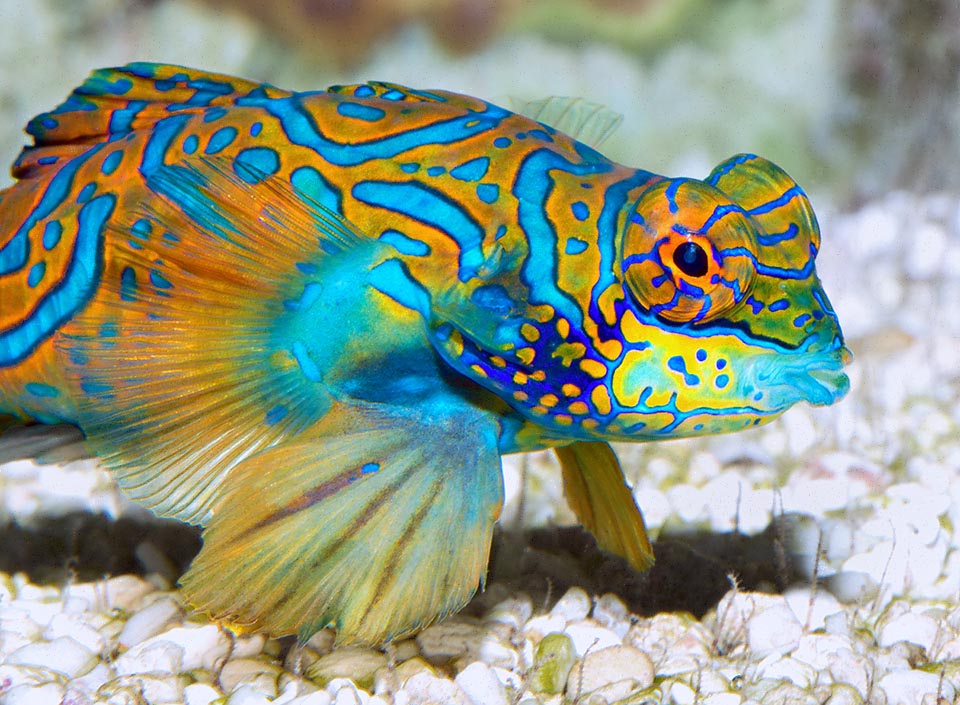
Synchiropus splendidus has reproduced in captivity, but to live it needs the large pools of the public aquaria, where over time have settled planktonic crustaceans © Giuseppe Mazza
Otherwise it is necessary to administer larvae of Artemia salina, or other microscopic species such as Cyclops and Mysis but it is not sure it likes them. Moreover, it is not possible to keep in the same pool two males who would fight like hell due to their innate territoriality.
The resilience of the species is excellent, as less than 15 months are necessary for doubling the populations, and the fishing vulnerability index is very low, marking only 11 on a scale of 100. In 2018 Synchiropus splendidus was inserted in the Red List of the endangered species as “Least Concern”.
Synonyms
Callionymus splendidus Herre, 1927; Neosynchiropus splendidus Herre, 1927; Pterosynchiropus splendidus Herre, 1927.
→ For general information about FISH please click here.
→ For general information about BONY FISH please click here
→ For general information about CARTILAGINOUS FISH please click here.
→ To appreciate the BIODIVERSITY of BONY FISH please click here.
→ To appreciate the BIODIVERSITY of CARTILAGINOUS FISH please click here.
